How to Make Pastry Cream
Learn how to make thick and creamy homemade pastry cream with this step-by-step guide. From eclairs to cream puffs this easy crème pâtissière recipe will equip you to make all your favorite cream-filled pasteries!
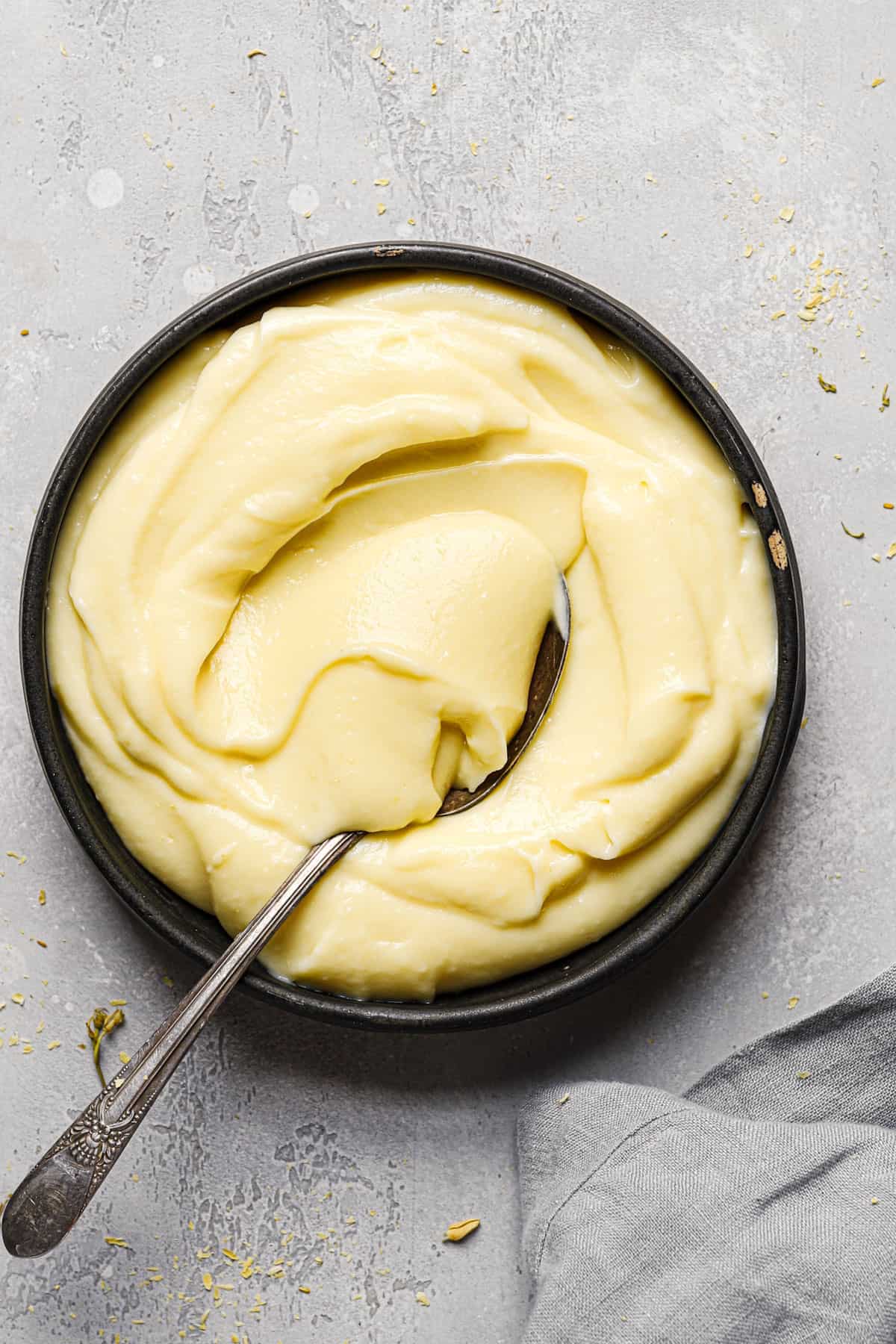
After years of making pastry cream, I want to equip each of you with the tools you will need to feel the joy of making your own pastry cream at home. I’m dishing out all my tips as well as how to troubleshoot any issues that might arise along the way.
Grab your whisk and let’s get baking!
The Background
Pastry cream, also known as crème pâtissière, is a rich, sweet custard-like filling used in many desserts. Made from sugar, eggs, milk, and starch this thick sweet cream is most often used for filling eclairs and cream puffs. It can also be used for fillings in tarts, the base for many cream pies, and filling doughnuts.
Often confused with custard, these two cream-based sweets share many similarities. Custard is the umbrella term used to describe many different dishes thickened with eggs. Custards can be both sweet or savory. Pastry cream on the other hand is a sweet custard that’s often thicker than other custards because of the use of a thickening agent such as cornstarch.
The Ingredients
- Sugar: Sweetens the pastry cream while also helping prevent the eggs from scrambling in the cooking process.
- Cornstarch: Used to thicken the crème pâtissière. Also makes this a gluten-free filling.
- Salt: Adds a little flavor.
- Egg Yolks: Gives flavor, a rich color, and a creamy finish.
- Whole Milk: Adds flavor while also preventing the eggs from scrambling in the cooking process.
- Butter: I use unsalted butter to give a smooth consistency to the pastry cream.
- Vanilla: Flavor, flavor, flavor!
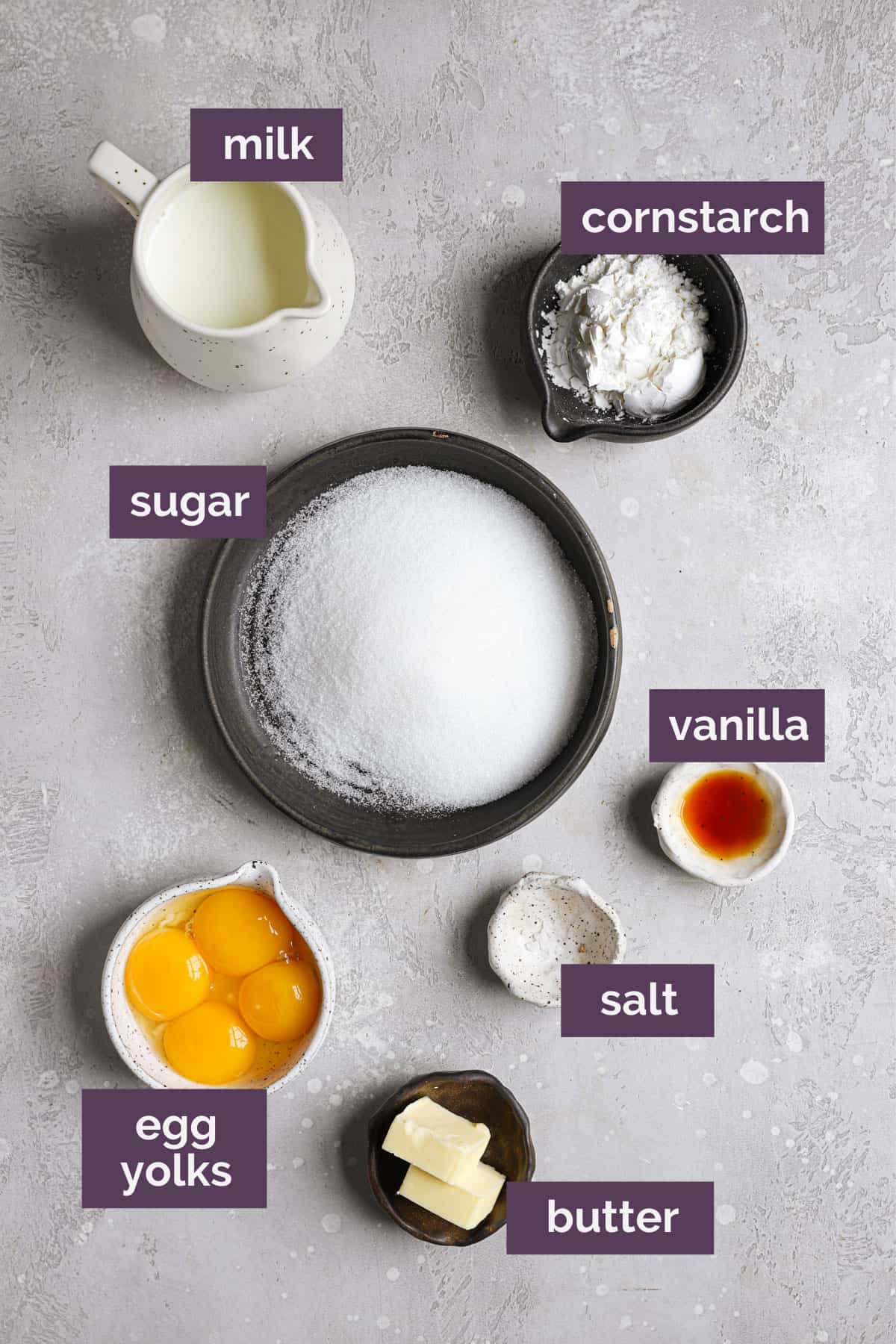
Step-by-Step Directions
Once you’ve gathered your ingredients, it’s time to cook up your pastry cream.
- Prepare an ice bath: Fill a large bowl with ice water, then set a fine-mesh sieve over a medium bowl. Set aside.
- Mix dry ingredients: In a 3 to 4-qt saucepan, whisk together sugar, cornstarch, and salt.
- Add egg yolks: Whisk in the egg yolks until thoroughly combined and all of the dry ingredients have been incorporated.
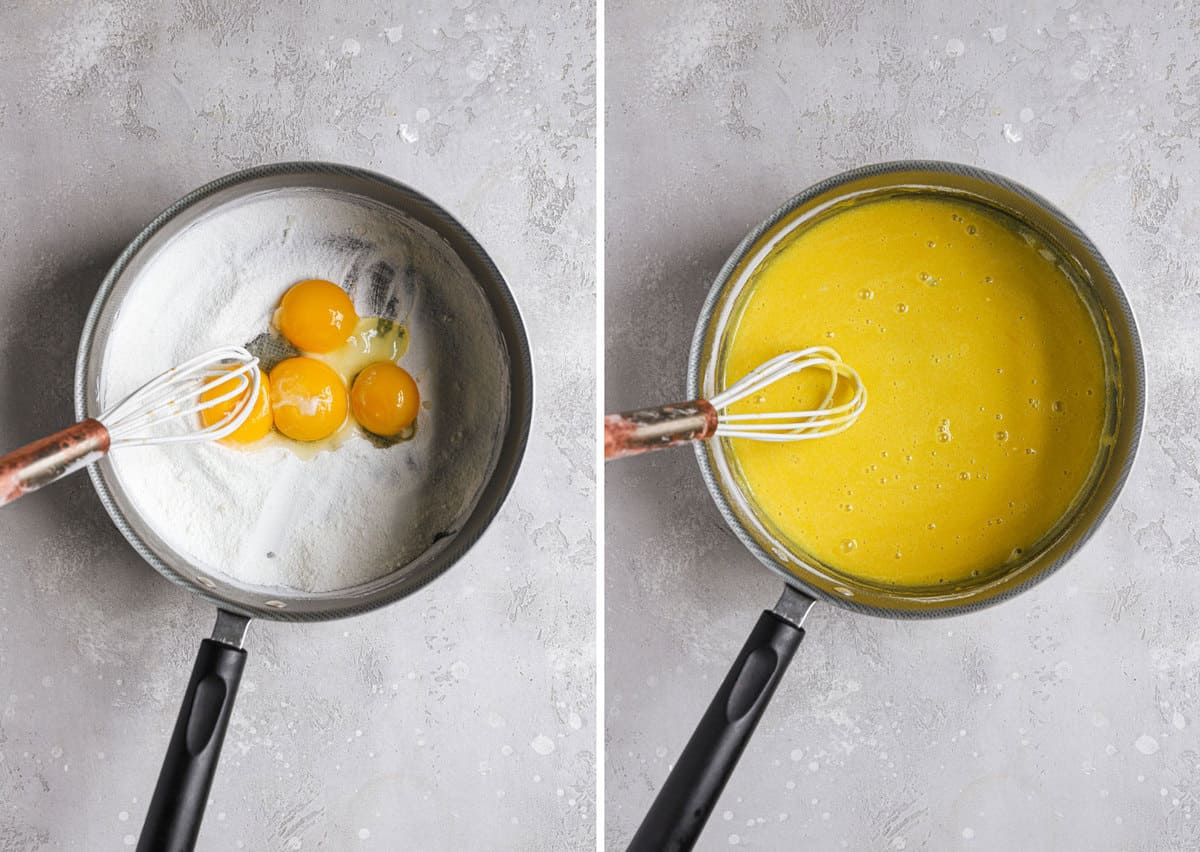
- Add milk: Then, whisk in the milk to combine.
- Heat to thicken: Place the saucepan over medium heat, whisking constantly, until the pastry cream begins to noticeably thicken, about 4 to 8 minutes.
- Look for bubbles: When it reaches this point, look for large bubbles to break on the surface. Once they do, whisk constantly for 1 minute, then remove from the heat.
- Add butter and vanilla: Whisk in the butter and vanilla until melted and completely smooth.
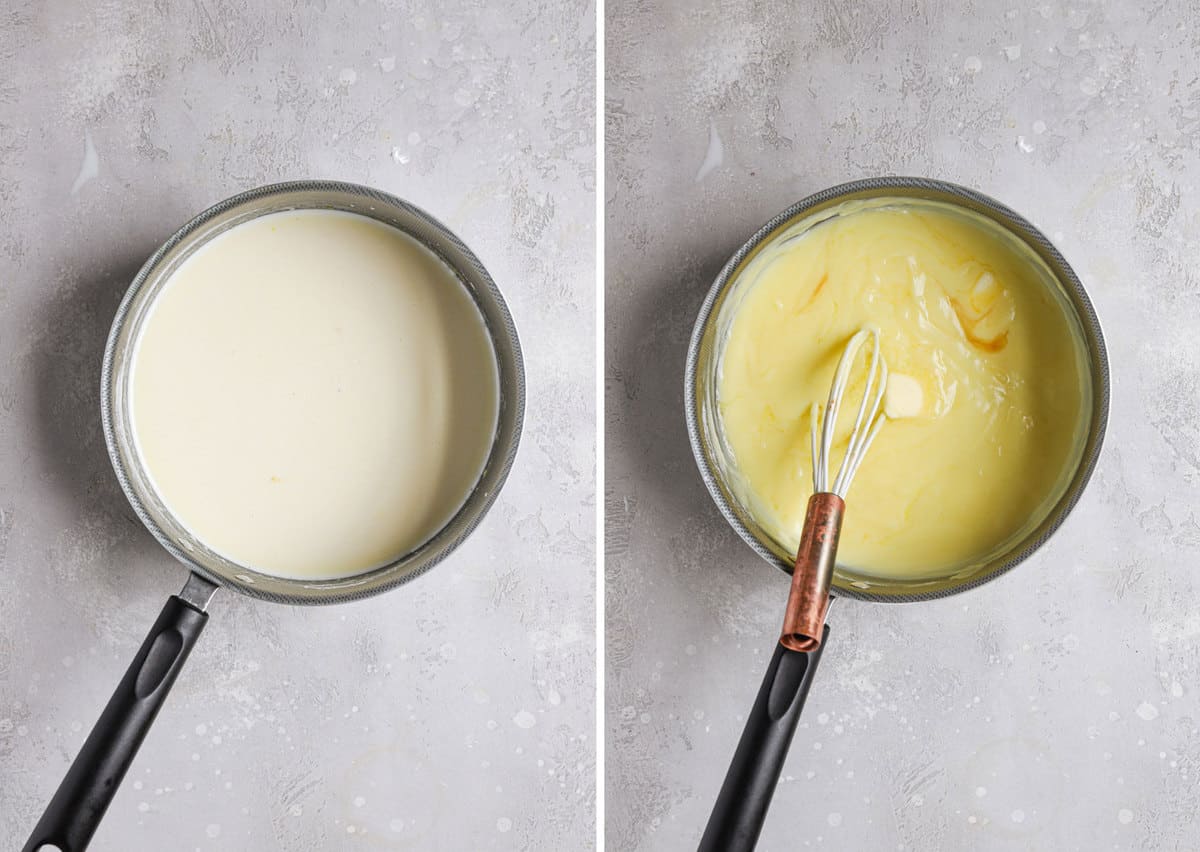
- Run through sieve: Strain the pastry cream through the fine-mesh sieve into the medium bowl.
- Cover: Immediately press a piece of plastic wrap against the surface of the crème pâtissière to prevent skin from forming.
- Chill in an ice bath: Place the bowl of pastry cream into the ice bath to cool for 30 minutes.
- Refrigerate: Transfer to the refrigerator and chill for at least 4 hours.
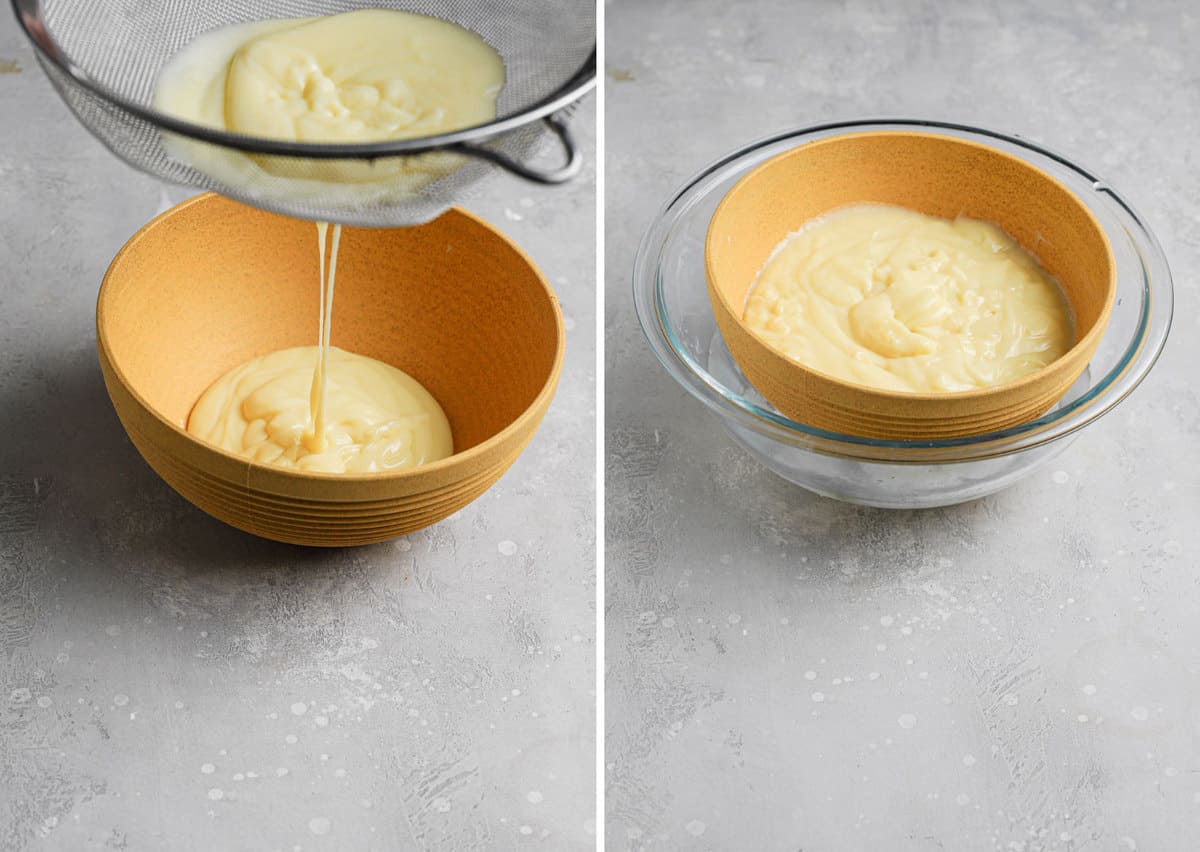
Troubleshooting and Recipe Tips
As with most recipes, making pastry cream gets easier the more often you make it. Here are a few of the most common issues that might arise while you are whipping up crème pâtissière and some ways to prevent or fix the issues as they come up.
Curdling
The most common concern when it comes to making crème pâtissière is curdling the eggs and ending up with a scrambled egg finish. While this concern is valid there are a few things working in your favor to prevent this from happening. First, the cornstarch helps prevent the eggs from scrambling. The milk also thins out the proteins in the egg to help prevent them from clumping together. Constant whisking will also help keep clumps from cooking into a sweet eggy mess.
If you still have lumps in your pastry cream simply run the finished product through a fine-mesh sieve to catch the cooked egg and work out the lumps.
Why boil pastry cream?
While you might be nervous about bringing the pastry cream to a boil, don’t! It’s important to make sure the cream reaches a boil to help break down the enzyme amylase in the egg yolks. By breaking down this enzyme you enable the crème pâtissière to set into a thick, creamy custard.
Because you are constantly whisking the pastry cream it might be hard to notice when the pastry cream is boiling. Here is how I check to know it’s bubbling:
- Once the cream has fully thickened, stop whisking and see if the cream bubbles up, pops, or sputters.
- If it does not, continue whisking another minute before stopping again to check for it to bubble or pop. Repeat until you see it bubble up.
- Once it starts bubbling, whisk constantly for 1 minute before removing from the heat and adding vanilla and butter.
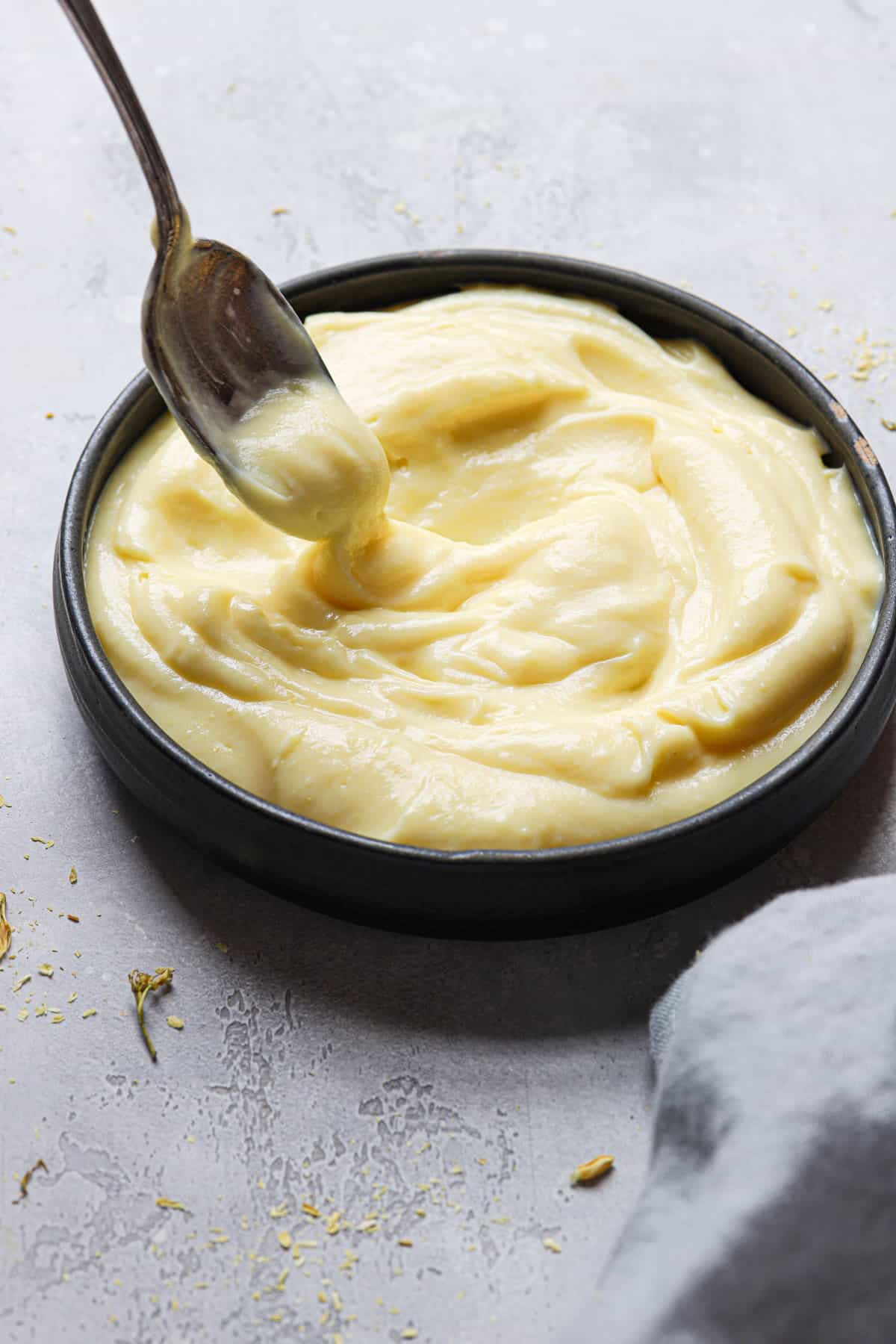
Loose Pastry Cream
Runny pastry cream most often comes from undercooking the egg yolk mixture. If you remove it from the heat too soon, the amylase in the egg yolks won’t break down and will prevent the cream from fully setting.
If you find your crème pâtissière is too thin, return to heat and bring to a boil over medium heat to thicken. (See notes above to know when the cream is boiling.)
Flavoring Options
Once you’ve mastered the classic vanilla, you are ready to take on any flavor your heart desires! Here are some other flavors you might want to try:
- Lemon: When you add the vanilla also add the juice and zest of a small lemon to give your pastry cream a tart lemony finish.
- Chocolate: Add 4 ounces of finely chopped dark or semisweet chocolate to the hot crème pâtissière when you add the vanilla and butter.
- Extracts: Try adding ¼ teaspoon almond, peppermint, or coconut extract to the custard along with the vanilla for different flavor profiles.
Storing and Making Ahead
- Storing: When you first make the pastry cream, it’s important to keep a layer of plastic wrap on top to prevent a skin from forming.
- Longer storage: Once fully chilled, keep in an airtight container in the refrigerator for up to 5 days.
- Making ahead: If you make the crème pâtissière in advance you might notice it gel up in the fridge. Simply smooth it out by whisking it up before using.
How to Use Pastry Cream
There are many different ways you can use this custardy filling, and these are some of my favorites:
- Eclairs and cream puffs: Fill shells of baked choux pastry with velvety smooth pastry cream for a delicious homemade treat.
- Banana Cream Pie: Use vanilla pastry cream as a base to build a decadent banana cream pie.
- Fruit Tarts: Inside of a baked tart crust, fill vanilla crème pâtissière and top with fresh fruit.
- Doughnut filling: Stuff your favorite doughnut with this silky-smooth cream for the ultimate cream-filled doughnut.
- Boston Cream: Use it as the filling for a Boston cream pie or Boston cream cupcakes!
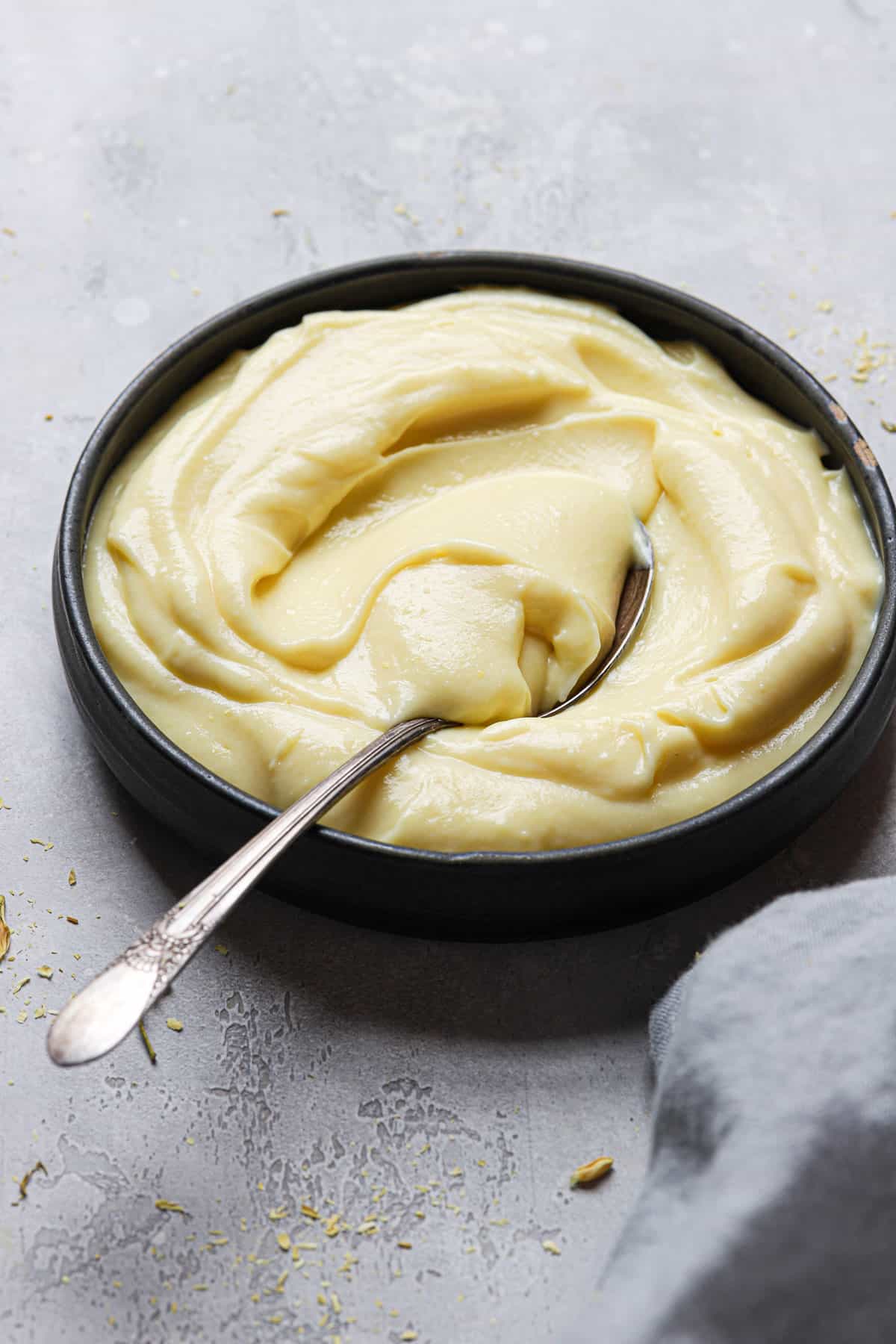
Watch the Recipe Video Below:
If you make this recipe and love it, remember to stop back and give it a 5-star rating – it helps others find the recipe! ❤️️
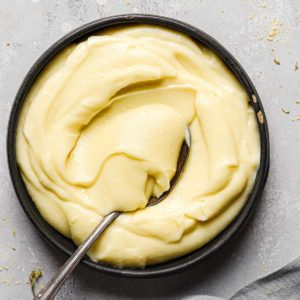
Pastry Cream
Ingredients
- ½ cup (99 g) granulated sugar
- 3 tablespoons cornstarch
- ¼ teaspoon (0.25 teaspoon) kosher salt
- 4 egg yolks
- 2 cups (480 ml) whole milk
- 2 tablespoons (28 g) unsalted butter
- 2 teaspoons vanilla extract
Instructions
- Fill a large bowl with ice water, then set a fine-mesh sieve over a medium bowl. Set both aside.
- In a 3 to 4-quart saucepan, whisk together the sugar, cornstarch and salt. Whisk in the egg yolks until thoroughly combined and all of the dry ingredients have been incorporated. Then, whisk in the milk to combine.
- Place the saucepan over medium heat, whisking constantly, until the pastry cream begins to noticeably thicken, about 4 to 8 minutes. When it reaches this point, look for large bubbles to break on the surface. Once they do, whisk constantly for 1 minute, then remove from the heat.
- Whisk in the butter and vanilla until melted and completely smooth.
- Strain the pastry cream through the fine-mesh sieve into the medium bowl. Immediately press a piece of plastic wrap against the surface of the pastry cream to prevent a skin from forming. Place the bowl of pastry cream into the ice bath to cool for 30 minutes. Transfer to the refrigerator and chill for at least 4 hours or overnight.
Notes
Flavoring Crème Pâtissière
Once you’ve mastered the classic vanilla, you are ready to take on any flavor your heart desires! Here are some other flavors you might want to try:- Lemon- When you add the vanilla also add the juice and zest of a small lemon to give your pastry cream a tart lemony finish.
- Chocolate- Add 4 ounces finely chopped dark or semisweet chocolate to the hot crème pâtissière when you add the vanilla and butter.
- Extracts- Try adding ¼ tsp almond or coconut extract to the custard along with the vanilla.
Storing and Making Ahead
- Storing- When you first make the pastry cream, it’s important to keep a layer of plastic wrap on top of the pastry cream to prevent a skin from forming.
- Longer storage- Once fully cooled, keep in an airtight container for up to 5 days.
- Making ahead- If you make the crème pâtissière in advance you might notice it gel up in the fridge. Simply smooth it out by whisking it up before using.
Did you make this recipe?
Leave a review below, then snap a picture and tag @thebrowneyedbaker on Instagram so I can see it!
Photography by Dee Frances






What happened to your recipe tempering the eggs???????? Why add milk and eggs together?
Thank you. Love the tips
Having just made your Boston cream pie recipe, I’m noticing this recipe is different than the one you have there. Fewer yolks and a completely different cooking process. Will this recipe work as well for filling as that one?
Hi Julie, Yes it definitely will!
Thank you for taking it back to the basics.
Love these simple recipe posts.
Thank you for a very thorough recipe for pastry cream with pictures. I have had a couple flops lately and this helped me iron things out.
Thank you very very much ❤️ You give me a huge help 😻🌹
I’m from other side of earth 😂 But I get your delicious cream 😋
I think it’s too late but I can’t leave without thanking you ☺️
I hope I write this correctly😅🙃
Hi .. Thank you for your recipe ? I will do it soon :)
sound good today i visit this blog and found it very helpfull good working keep it up
WOW, I cant wait to try this!!
hello Michelle,
to prevent pastry cream from skin forming, can I just pour the pastry cream into piping bag and refrigerated it before I used it for my choux filling?
Hi Lilyn, I’m not sure if that would work, because the pastry cream needs to thicken up in the refrigerator. It would probably be easier to have it in a bowl, then whisk before using. If you use a pastry bag, let me know how it works.
Wow I’m glad I found this site. Just what I was looking for. Great directions and pics. Making this a fav. Thanks for sharing your baking knowledge. Kim
I also just saw the show with Bobby Flay and wondered if you had the recipe for the frosting too!
Hey is there anyway to make the filling from salted sugar?
Sorry salted butter?
Hi Melz, Yes, you can. Just omit the pinch of salt from the recipe.
Thank you for such a great tutorial! My 11 year old stepdaughter asked for Boston Cream Pie for her birthday this year and this recipe and tutorial helped me immensely! I have never made pastry cream before and this tutorial definitely helped ensure I didn’t end up with sweet scrambled eggs. It ended up SUPER thick (thicker than any other pastry cream I’ve ever had), so I think I must have overcooked it, but it still tasted yummy and the birthday girl was happy.
This is great! I used this cream tonight as a filling for my St. Joseph’s Day Zeppole! It turned out delicious! Thanks for sharing this and the pictures helped tremendously!
Hi, I was wondering if this recipe for pastry cream can be used as a filling for a tart with a fruit topping. The last recipe I tried didn’t work out because once cut, the cream oozed and left a very messy dessert. Thanks!
Hi Meaghan, You could definitely use this! Just make sure you chill it and let it set before cutting!
Thank you SO MUCH for an easy to make, and fantastically Tasty Pastry Cream Recipe! I Loved it, and the directions were great! Thanks again, and my Croquembouche Is coming out Wonderfully, which is what I’m making the Cream Puffs For! :-) Thanks again!
Christine
I linked your Pastry Cream tutorial in my July 4th post.
It is a great tutorial. Thanks!
Carmen of Baking is my Zen
http://bakingismyzen.blogspot.com/2010/07/celebrate-july-4th-with-pastry-cream.html
Can a cake filled with pastry cream and fresh strawberries be frozen? I plan to ice the cake with real whipped cream. Make it today Wed and serve it Sat. Thank you for your help.
Hi Jeannette, I don’t know that I would freeze the cake filled and frosted. I don’t think the pastry cream and whipped cream icing would hold up very well. I would recommend baking the cake today, wrapping and freezing it. And then you could make the pastry cream and refrigerate it (making sure to press the plastic wrap against the top of the cream so it doesn’t form a skin in the refrigerator). You could even make the whipped cream frosting the night before and refrigerate it. Then I would assemble and frost the cake the day that you plan to serve it (in this case, Saturday).
Thank you so much! I tried making pastry cream before in a Boston Cream Pie for my boyfriend’s family – but had one of those horror stories of scrambled eggs in the cream :-/ but thanks to this – I finally made it perfectly smooth and creamy. It was a lot easier than I thought! Thanks again!
Profiteroles, thats what I like to fill with pastry cream as well as Cannoli! Thanks and keep up the great work!
Michelle
Never made this before turned out very tasteee!
Recipe? I could just eat it with a spoon.
So, it is 9:47am and I am now craving eclairs! This is a great tutorial!
What a fun post! Like you, I always strain pastry creams and custards – you can never be too careful :)
Awesome pictures and demo. How helpful!
Thanks for the awesome tutorial, I’ve made pastry creme before, but this is a nice reference point!
thanks brown eyed baker! this is WONDERFUL!!
Yum! I love cream puffs. I think they are probably my favorite dessert ever!
Yay for another tutorial! I love all the helpful pictures, your pastry cream looks perfect!
Okay I am addicted to pastry cream, I love custard eclairs and was just thinking I need to find a recipe for good pastry cream and then you posted this. I am so excited to try your recipe!
Thanks for putting this together. Looks so much less daunting that way that you detailed it out. I don’t really do pastries and these CIA cookbook scared me a plenty from trying, but your steps encourage me to give pastry cream a try. Thanks again for sharing. One question: if I wanted to use whole milk could I build it up with pectin or gelatin?
great post…love the step-by-step with photos. Can’t wait to try this one. Question: what is the phonetic spelling of pâte à choux? Would be nice to pronounce it correctly when trying to impress my official tasters.
Thank you so much for this!
OMG, those are SO scrumptious looking!
I have always been intimidated to try this. But after this post. I think I will give it a try. Thanks for sharing.
Hello! I’m a recent follower of your blog and this is my first time commenting, because I have to thank you for this tutorial! Pastry cream vexes me so! The first (and, admittedly, only) time I made it, it curdled a bit on me (maybe I cooked it too long?) and then never thickened up. It tasted good, but the end result was a soupy mess when I tried to use it in a tart. Do you have any secrets for how to make sure it thickens properly, or do you just go by feel?
Yum! I love pastry cream, its so sweet, creamy and versatile. I always add a touch of vanilla bean paste. I bet this post will help a lot of first time pastry cream makers!!
great demonstrative pictures. maybe someday I’ll get enough never to try this…looks doable and very yummy.
I love this post!
I am not sure if I have a favorite recipe that uses pastry cream, but I made a lemon/ginger flavored pastry cream that was really delicious and put it in pistachio tart shells.
Thank you for this…I have wanted to give pastry cream a try, but like you, I have heard horror stories ans was a little scerred ;)
Anyway, you have now just made it doable for me~ thanks!
My favorite recipe that includes pastry cream is orange surprise. Cut the top 1/4 from a large orange. Carefully remove the orange flesh with a tablespoon being careful not to puncture the shell. I like to cut a crinkle design in the “rim” of the orange shell. Remove some orange segments from the flesh and mix with pasty cream and a bit of whipped cream to lighten it. Fill shell to within 1/4 inch of rim. Pipe meringue onto the orange shell and then bake at 400 (I put the orange onto a ramekin to keep it upright) until the meringue is lightly browned. Serve garnished with a couple of orange leaves (not edible). I like this because it uses the whole egg: the yolks for the pastry cream and the whites for the meringue.
You can also pasteurize eggs yourself by heating the eggs to 150 degrees for 5 minutes. I use a frothing thermometer to maintain the temp exactly since 150 is optimal frothing temp too. If you overheat the eggs they will cook a bit near the shell. Since pastry cream only uses the yolks it isn’t a problem. Use the left over egg whites for an egg white omelet.
This has been on my agenda since last month…need to give it a try! Wonderful photos. Thanks!
Yum, yum, yum! My favorite recipe with pastry cream definitely has to be cream puffs!